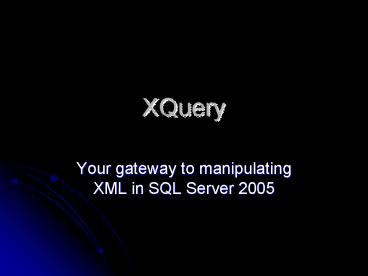XQuery - PowerPoint PPT Presentation
1 / 22
Title:
XQuery
Description:
TMA Resources, Leader in Member-centric Software. Microsoft MCP (just shy of my MCAD) ... Kent Tegels, DevelopMentor, MVP. http://sqljunkies.com/WebLog/ktegels ... – PowerPoint PPT presentation
Number of Views:42
Avg rating:3.0/5.0
Title: XQuery
1
XQuery
- Your gateway to manipulating XML in SQL Server
2005
2
About the Speaker
- Hal Hayes
- Hal.hayes_at_tmaresources.com
- Sr. Director, Software Engineering
- TMA Resources, Leader in Member-centric Software
- Microsoft MCP (just shy of my MCAD)
- Founder, CAPAREA (formerly CAVBUG)
- Learning Tree Instructor (SQL Server)
gratuitous aircraft picture
3
Agenda
- XQuery Defined
- Working with XML in SQL Server 2005
- Advanced Usage
- Topic Maps
- Recommendations
- Resources
4
What you should know...
- XML
- XML Schemas
- XPath and XSLT
- Working with XML in .NET
- Working with XML in SQL Server
5
What is XQuery???
- XML-based functional, declarative query language
- XQuery is SQL-like
- Fine-grained querying against native XML
(hierarchical vs. flat table/record format for
SQL) - Syntax is straight-forward making it easy (??) to
query your XML data - Standards Based. Currently a W3C Candidate
Recommendation - W3 standardized language (http//www.w3.org/XML/Q
uery)
6
XQuery in SQL Server 2005
- A subset of full language
- Namespace aware
- Can work with or without a Schema (strong vs.
weak-typed) - One major differenceno let statement!
7
XQuery Basics
- FLOWR
- XPath
- Comments
8
FLOWR
ltbibgt for b in doc("bib.xml")/bib/book
where b/publisher Microsft" and b/_at_year
gt 1991 return ltbook year" b/_at_year "gt
b/title lt/bookgt lt/bibgt
- Main construct of XQuery is the FLOWR expression
- For-Let-Where-Order-Return
- equivalence to SELECT-FROM-HAVING-WHERE in SQL
- Use the Return construct to shape your results
9
FLOWR (continued)
- for clause provides a definition of a variable
and binding of iterations across a range of
sequence values (SQL-SELECT) - let clause allows association of a variable to a
further ordered list of tuples (SQL-SET) - where clause is a filter of the current sequence
or tuples from for/let (SQL-WHERE) - order clause sorts current results based on a
given criteria (SQL-ORDER) - return clause is used to create output that can
be XML or not XML (SQL-RETURN)
10
Two Examples
- Standard Recommendation XQuery
- (using XMLSpy)
- SQL Server 2005 Version
11
Additional XML Data Type Methods In SQL 2005
- Column.query()
- Column.value()
- Column.modify()
- Column.nodes()
- Column.exists()
12
XQuery DML
- Column.query(statement)
- Use XQuery statement, or
- XPath
- Declaration of a namespace
- Can return XML
- Column.value(statement, type)
- Returns a value
- Use SQL types (i.e. varchar(255))
13
XQuery DML
- Column.nodes()
- Useful for shredding an XML document into its
constituent parts. - If used in the WHERE clause, can be used in
conjunction with .query(), .exist(), .value(),
and .nodes() (but not .modify()) - Column.exist()
- Returns a 1 (representing True) if the XQuery
expression in a query returns a nonempty result
(meaning it returns at least one XML node). - Returns a 0 (representing False) if the XQuery
returns and empty result.
14
XQuery DML
- Column.modify()
- Used for XML DML operations (non-query)
- update, delete, replace value of
- Executed as part of the DML Update statement
UPDATE customerData SET customerDocs.modify(' ins
ert lthistorygtno history availablelt/historygt as
first into (//customer)1')
15
Demos
- With some basic stuff
- Maybe some advanced stuff, too!
16
Quick Introduction to Topic Maps
- Constructs for creating a meta-model of data and
information - Topic Maps are XML based
- Current (pending) standard is XTM 2.0 (ISO)
17
Topic Map Fundamentals
An Introduction to Topic Maps, Kal Ahmed and
Graham Moore, The Architectural Journal,
http//www.architecturejournal.net/2005/issue5/Jou
r5Intro/
18
Topic Map Demo
19
Recommendations
- For getting at detail in your XML documents
stored in the database, XQuery is a great tool. - Dont rely on the XQuery Where clauseyou could
retrieve empty records! - Strong-typed (mapped to Schema) XML Data Columns
will have better performance than weak-typed. - DML is limited. You have better choices for
manipulation (i.e. .NET XML, XLinq) - Dynamic Parameterized XQueries are problematic,
but can be done. Best bet is to encase them in
StoredProcs.
20
Resources
- W3C XQuery Working Group
- http//www.w3.org/XML/Query
- Topic Map ISO
- http//www.isotopicmaps.org/sam/sam-xtm/
- Topic Map Consortium
- http//www.topicmaps.org
21
Books
- A Developer's Guide to SQL Server 2005 ,
Beauchemin, Berglund, Sullivan Addison-Wesley - XQuery Kick Start, James McGovern, et al. SAMS
- XQuery, The XML Query Language, Michael Brundage,
Addison-Wesley - XQuery from the Experts, Don Chamberlin, et al.,
Addison-Wesley
22
Blogs of Note
- Michael Rys, Program Manager for SQL Server's
XML Technologies and member of W3 XML Query
Working Group - http//sqljunkies.com/WebLog/mrys
- Kent Tegels, DevelopMentor, MVP
- http//sqljunkies.com/WebLog/ktegels
- Mike Champion, Program Manager for XML Standards
XML WebData team at Microsoft - http//blogs.msdn.com/mikechampion
- Shankar Pal, XML SQL Program Manager, Microsoft
Corporation - http//blogs.msdn.com/spal
- Microsoft Corporation XML Team Weblog
- http//blogs.msdn.com/xmlteam/default.aspx
- Bob Beauchemin's Blog, Author of A First Look at
SQL Server 2005 for Developers - http//staff.develop.com/bobb/weblog/default.aspx































